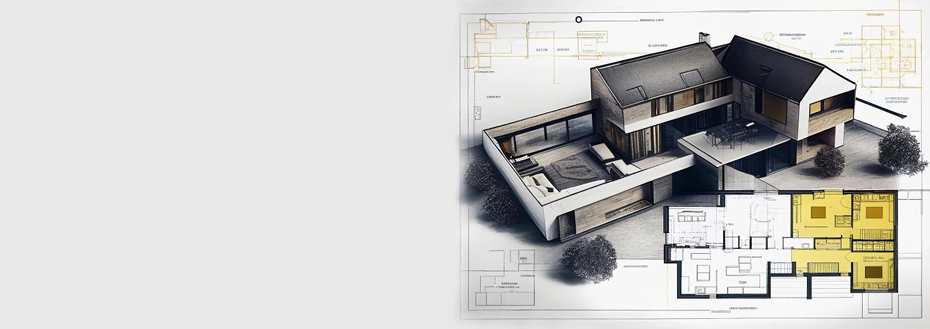As the field of engineering continues to evolve, the role of computer-aided engineering design becomes increasingly critical in shaping the future. The convergence of architectural and engineering computer-aided design has opened new horizons, enabling us to envision and build structures and systems that were once thought impossible. Computer aided engineering design solutions have fundamentally transformed the processes of civil engineering drawing and design, allowing for greater precision, efficiency, and innovation.
In the modern world, progress and innovation are significantly driven by technology, with developments in Computer-Aided Design (CAD) playing a transformative role in the field of engineering. CAD is the use of computer technology to create, edit, optimize, analyze, and manufacture models or drawings of parts and assemblies. Ranging from two-dimensional drawings to three-dimensional models, CAD is widely used across all fields of engineering and architecture, where every physical product imaginable is first created within the virtual realm of computer-aided design.
The Power of Computer-Aided Design
Imagination and creativity are the cornerstone of engineering, and nowhere is this more apparent than within the realm of CAD. This potent tool elevates engineering to new levels of precision and efficiency. Engineers can use 2D CAD design and 3D CAD drawing services to create, analyze, and modify their designs with an unprecedented level of convenience and detail. By simulating various conditions and environments, engineers can thoroughly analyze and refine their designs before any physical prototype is built, thus reducing cost and streamlining turnarounds.
Functionalities of Computer-Aided Design (CAD)
Whether in mechanical, civil, or architectural engineering, computer-aided design offers multifunctional tools that accentuate engineering capabilities. These tools allow engineers to draft, draw, and design models with CAD, creating a digital twin of the physical world. Moreover, 'engineering software CAD' enables intelligent object recognition, automation of design processes, easy modification, optimization of designs, collision detection, and documentation of designs.
The Genesis of CAD: Revolutionizing Engineering Design
Since its inception in the 1960s, CAD has radically revolutionized 'computer-aided engineering design.' The transition from manual drafting to 'architectural and engineering computer-aided design' marked a pivotal moment in the architectural and engineering industry, streamlining the design process. CAD has brought enhanced accuracy and precision, opening new gateways for design optimization and innovation. The ability to directly transform CAD models into manufacturing data has streamlined the design-to-manufacturing process, removing the potential for human error and vastly improving accuracy.
Uses of CAD in Engineering
CAD has exponentially expanded its influence across multiple engineering domains, providing 'CAD design engineering services' and leading to more intelligent designs.
- In civil engineering, CAD enhances the design and planning of infrastructures such as roads and bridges. It facilitates precision and efficiency in design and construction processes.
- CAE (Computer-Aided Engineering) tools allow for simulation and analysis, which enable engineers to visualize the performance of their designs under various conditions before they are physically created.
- In mechanical engineering, CAD is where ideas become tangible designs. It's used to craft parts and assemblies for machinery and vehicles and to test these designs under simulated stress conditions.
- In mechanical engineering, CAD is where ideas become tangible designs. It's used to craft parts and assemblies for machinery and vehicles and to test these designs under simulated stress conditions.
- CAD also serves as the blueprint creator for circuit boards and electronic components. It allows for the layout of wiring diagrams and the simulation of electronic device functionality.
- In architectural engineering, CAD is the drafting table for architectural projects. It's used to create everything from floor plans to 3D renderings and to simulate factors like energy usage or lighting in designs.
- For aerospace engineers, CAD is a virtual testing and planning tool. It's used to design components for aircraft and spacecraft, simulate aerodynamics, and create manufacturing plans and assembly instructions.
- Additionally, CAD also acts as the virtual garage for vehicle designs. It's used to design parts, assemblies, and full vehicles, and to conduct crash and safety simulations.
Across all fields, CAD stands as the virtual workspace where engineers bring their designs to life, test, and refine them before they're physically built.
Benefits of computer-aided design (CAD) in the engineering industry
The benefits of CAD in the engineering industry are multifold. Improved collaboration and documentation, coupled with the consistency in design that CAD tools provide, are significant. CAD also increases cost efficiency by reducing wastage of resources during the design phase. Faster execution of designs is facilitated by the CAD system's ability to manipulate and modify designs quickly. Thus, resulting in better quality designs that fit the bill of requirements accurately. CAD setups provide more control and precision, laying the manufacturing foundation, and saving time by automating tedious manual drawing tasks, enabling design engineers to focus more on innovation than on the intricacies of the design tools.
The Future of CAD
The future pulse of CAD is AI, VR, and AR, ushering in a new era of Engineering CAD design services. While AI predicts outcomes and generates designs, VR and AR will revolutionize how engineers interact with their designs. This opens exciting possibilities, like holographic Computer aided engineering design or real-time virtual reality design feedback sessions.
Conclusion
The power of CAD lies in its ability to revolutionize engineering processes, empowering engineers to create intricate designs efficiently. From 2D CAD design to 3D model engineering drawing, and the anticipation of AI, VR, and AR in engineering software CAD presents an exciting futurist landscape full of endless possibilities. As CAD continually grows and evolves, engineers can look forward to an increasingly dynamic and immersive digital design experience that will not only revolutionize their approach to design but also redefine the modern world.
Outsource CAD Services to Flatworld Solutions
We offer professional and reliable CAD design engineering services to businesses across engineering sectors. Our team, armed with advanced technology, ensures accurate, timely, and cost-effective services. Why worry about juggling the complexities of design and detail work, when you can outsource your CAD requirements to us? We will handle your engineering designs while you focus on your business growth.
The range of tasks that can be outsourced to a CAD service provider is vast. Services pertaining to 2D CAD design, 3D modeling, structural analysis, design and simulation, architectural CAD drafting services, and engineering CAD design services can be effectively managed by an outsourced team. Delegating these tasks to a team of professionals ensures accuracy, efficiency, and adherence to industry regulations and standards.
Embrace the benefits of outsourced CAD services, and we'll help you accelerate your design process, enhance product quality and substantially reduce design costs - leaving you free to focus on the bigger picture of innovation and growth.
Contact UsAvail best-in-class services at affordable rates
Our Customers





Key Differentiators
Case Studies
-
Flatworld Solutions provided customized CNC programming using MasterCAM
-
Flatworld Provided CFD Simulation Services to a Leading HVAC Products Manufacturer
-
Flatworld Solutions Offered Mechanical Instrument Drafting and Detailing Services to an Engineering Consultant
-
Flatworld Solutions Offered US Client with 2D to 3D Mechanical Legacy Drawing Conversion
-
Flatworld Solutions Provided Reverse Engineering of Machine Parts to a Client
Join the growth phase at Flatworld Solutions as a Partner
Service distributorship and Marketing partner roles are available in select countries. If you have a local sales team or are a person of influence in key areas of outsourcing, it's time to engage fruitfully to ensure long term financial benefits. Currently business partnerships are open for Photo Editing, Graphic Design, Desktop Publishing, 2D and 3D Animation, Video Editing, CAD Engineering Design and Virtual Walkthroughs.
Reach out to us for a quick direct response from decision makers at the Flatworld Solutions global team.
Frequently Asked Questions (FAQs)

USA
Flatworld Solutions
116 Village Blvd, Suite 200, Princeton, NJ 08540
PHILIPPINES
Aeon Towers, J.P. Laurel Avenue, Bajada, Davao 8000
KSS Building, Buhangin Road Cor Olive Street, Davao City 8000
INDIA
Survey No.11, 3rd Floor, Indraprastha, Gubbi Cross, 81,
Hennur Bagalur Main Rd, Kuvempu Layout, Kothanur, Bengaluru, Karnataka 560077



